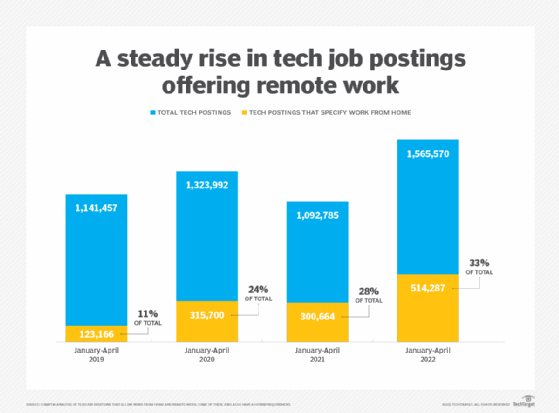
daniilvolkov - stock.adobe.com
Apple's hybrid work plans draw worker pushback
Apple's executives say in-person collaboration is essential to the company's innovative culture. Employees have asked the company to rethink forced hybrid work.
Apple employees have pushed back against the company's hybrid work plans, arguing that the vendor can build innovative products without in-person collaboration.
On Monday, a group of employees called AppleTogether, started a petition to protest an Apple pilot plan that would force workers into the office at least three days a week. As of Tuesday afternoon, the petition had garnered 765 signatures, though it's uncertain how many of the signees are among Apple's 165,000 employees.
Apple introduced its hybrid plan this month, according to a Bloomberg report. It required all employees to work in the office on Tuesdays and Thursdays and let individual teams decide on the third day. In memos leaked to The Verge, Apple executives stressed the importance of returning to the office, with CEO Tim Cook calling in-person collaboration "essential to our culture."
Apple did not respond to a request for comment.
The employee petition calls for Apple to encourage work from any location, saying it would lead to a more diverse and successful company.
"Office-bound work is a technology from the last century," the group wrote on its website, noting the rise of video conferencing and chat applications. "The future is about connecting when it makes sense, with people who have relevant input, no matter where they are based."
Apple's insistence on workers being physically present in the office is strange, former Apple employee Janneke Parrish said. Parrish, a leader of the AppleTogether movement before being fired in 2021, was a program manager for Apple Maps and worked as part of a far-flung international unit.
"If collaboration was honestly impossible in a remote team, it seems like mine should never have worked," she said. "But the reality is, my team, the [points of interest] team, did amazing work."
Apple will miss out on another benefit of in-person work: serendipitous interactions between coworkers that spark inspiration for new products or features, Parrish said. The company's focus on secrecy makes cross-unit conversations dangerous.
"We had nondisclosure agreements out the wazoo," Parrish said. As a result, she didn't always know another team's work across the hall.
"For me, if I talked to somebody about my project, I'd lose my job," she said.
Apple has tried to bring its workers back to the office before. In the spring, the company had a hybrid-work plan derailed by a resurgence of COVID-19. The unpredictable nature of the pandemic also wreaked havoc on the return-to-office plans for fellow tech giants Microsoft and Amazon.

Apple is not alone in thinking remote work stymies innovation. This month, JPMorgan Chase CEO Jamie Dimon said remote work limits spontaneity and slows decision-making. Tesla Motors CEO Elon Musk ordered his workforce back, saying personal presence is necessary to build the products the company needs.
"Tesla has and will create and actually manufacture the most exciting and meaningful products of any company on Earth. This will not happen by phoning it in," he wrote in a leaked email to employees.
But big-name CEOs favoring in-office work doesn't change the fact that meaningful interactions are rare in the office, University of Texas business professor Andrew Brodsky said. Companies would be better off finding new ways to spark inspiration than giving up remote work's work-life balance and productivity benefits.
"I think because people are so anchored in the old way of work, they're very much over-emphasizing what's lost," Brodsky said. "You don't want to throw out the baby with the bathwater with remote work."
Mike Gleason is a reporter covering unified communications and collaboration tools. He previously covered communities in the MetroWest region of Massachusetts for the Milford Daily News, Walpole Times, Sharon Advocate and Medfield Press. He has also worked for newspapers in central Massachusetts and southwestern Vermont and served as a local editor for Patch. He can be found on Twitter at @MGleason_TT.







